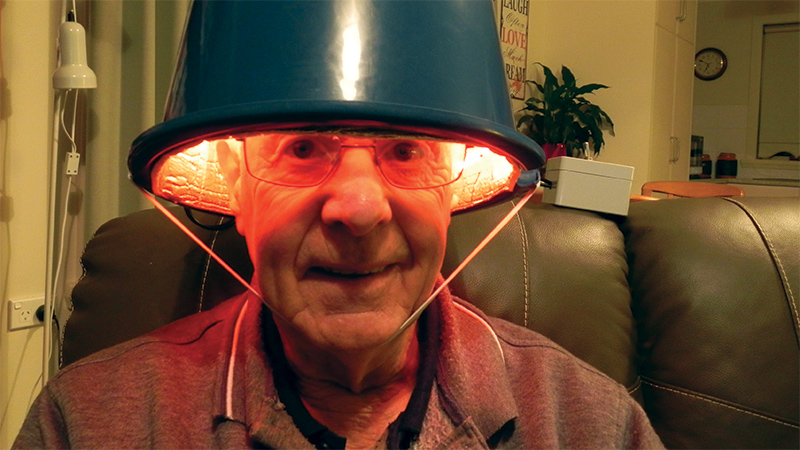Light therapy for Parkinson’s disease gives new hope
February 1, 2018

On a crisp and clear autumn day two years ago, retired federal politician Max Burr was sitting in front of his computer at home in Launceston, Tasmania, desperately seeking help.
Burr, a Liberal MP from 1975 to 1993, was diagnosed with Parkinson’s disease in 2012. Much to his dismay, he was told three years later by his geriatrician, Dr Frank Nicklason, that his condition was deteriorating and that he needed to increase the dosage of his medication even further.
“I said to Frank, ‘No, I’ll find other methods,’” Burr recalls.
With the tenacity of a seasoned politician, Burr, 78, opened his laptop and began to search. Before long he found a research paper on the use of photobiomodulation—the term used for light’s ability to affect key biological processes at a cellular or even genetic level—in animal testing for Parkinson’s disease, published by Sydney University’s Professor John Mitrofanis.
“The paper showed that the use of 670-nanometre red light was protective of neurons in Parkinson’s,” Burr says. “So I sent Professor Mitrofanis an email and said, ‘Look, this is all very interesting, I wouldn’t mind having a crack at it.’”
Parkinson’s disease—first described by English surgeon James Parkinson in his 1817 work “An Essay on the Shaking Palsy”—is a combination of movement disorders, associated with neuropsychiatric problems and physical instability. It affects approximately 79,000 people in Australia and New Zealand and accounts for nearly 2000 deaths annually. Its cause remains a mystery, but it is known to be associated with dopamine depletion and loss of neurons in the basal ganglia region of the midbrain.
The current mainstay of treatment involves physical therapy as well as medications that act to increase dopamine levels in the brain. These medications can provide significant improvements in the symptoms of Parkinson’s disease but their effectiveness tends to wear off with time and they can cause a number of toxic side-effects.
Mitrofanis, Professor of Anatomy at the University of Sydney’s School of Medical Sciences, is considered a luminary in Parkinson’s disease research. Despite being excited by the laboratory results on light therapy, he had no choice but to tell Burr that all the work was pre-clinical, and he couldn’t recommend it to humans yet.
Aware that his condition was not going to wait while scientists went through the long process of obtaining approval for human trials, Burr went ahead and built a homemade device from an aluminium-foil-covered lampshade lined with strips of LED bulbs that emitted red light at a wavelength of 670 nanometres. Once completed he began using the device, which rested on his head, with the lights switched on, for 20 minutes twice a day.
Burr’s description of what happened is remarkable. “I recovered my sense of smell, my writing is now firm and concise, my gait has improved and I can climb stairs,” he says. “From week to week, it might have only been a subtle change, but the cumulative effect over the months has been quite significant.”
Dr Daniel Johnstone, 35, a medical scientist at the University of Sydney’s medical research centre, the Bosch Institute, has been involved in a number of animal experiments on the use of photobiomodulation for Parkinson’s and believes red and infrared light therapy can provide benefit.
“The exact mechanisms are still not totally known, but we do know that there’s a key enzyme in the cells that absorbs light at certain wavelengths and triggers this intracellular cascade signalling that seems to collectively lead to a protective effect,” he explains to me.
In one of Johnstone’s experiments, mice that were injected with MPTP—a potent neurotoxin that induces Parkinsonism in animals—were given either no infrared light, bursts of infrared light to their head and body, or light to their body alone. Six days later, all were euthanised and their brains were examined.
As expected, researchers found that mice injected with MPTP had increased neural cell loss in the substantia nigra, compared to mice that had not been injected. But this loss was significantly reduced in mice exposed to infrared light, even if the exposure was to the body only and not directly to the brain.
“Similar findings are coming out from researchers all over the world,” Johnstone says.
Johnstone’s supervisor at the Bosch Institute is executive director Professor Jonathan Stone.
“Despite a lot of scepticism, people are being drawn into it by the fact that it [light therapy] works,” Stone, who is 74, told me. “There’s growing evidence that it works against depression and stroke and in the cognitive aspects of Alzheimer’s disease. And it’s so blessedly free of side-effects that you can use it without having to know down to the last molecular detail how it works.”
Johnstone subsequently travelled to a specialised primate research facility in Grenoble, France, in order to conduct further experiments.
“The results were extraordinary,” Johnstone says. “We found that infrared light treatment offered really strong neuroprotection and reduced clinical symptoms of Parkinsonism in the monkeys.”
As a staff specialist at the Royal Hobart Hospital, Nicklason sees many patients with Parkinson’s disease and other neurological conditions. Although he advises prudence he sometimes provides research information about light therapy to his patients.
One of these patients is Peter Cheatham, a former mountaineer and rescue-work trainer who was diagnosed with Parkinsonism following a series of strokes in his basal ganglia. Cheatham is using one of several mobile infrared light devices produced and marketed by Vielight, a company based in Canada.
“Within a couple of weeks of usage my twitching stopped and I started remembering things I had forgotten,” Cheatham says. When I phoned him he was out collecting donations for the Salvation Army. “Now I can hold a conversation again and I can write legibly too. I’ve come off a lot of my medications and everything around me is clearer.”
Gold Coast-based general practitioner Dr Mark Jeffery has a number of patients with Parkinson’s disease in his practice. He believes patients with Parkinson’s as well as Alzheimer’s disease could potentially benefit from infrared light therapy, but he is cautious about recommending devices like those produced by Vielight, due to the tricky nature of what he calls “off-label” prescribing.
“If you don’t investigate a patient properly and they deteriorate, it would be hard to justify in court that you prescribed a device that wasn’t proven to help,” he says.
Professor Simon Lewis, a consultant neurologist at the Royal Prince Alfred Hospital and Professor of Cognitive Neuroscience at the University of Sydney, advises that more research is needed before photobiomodulation is used as a mode of treatment.
“It’s encouraging research, but we must strike a balance between hope and hype,” Lewis says.
Vielight founder Lew Lim, a self-described “naturopathic doctor” and engineer, is eager to argue that there is evidence behind his devices. He claims his company, which has sold in excess of 30,000 units, has undertaken studies showing their neuroprotective benefits.
“We’ve had some really dramatic, positive outcomes,” he informed me recently during a trip to Australia to meet with researchers at the Bosch Institute. “People have told me that this has literally saved their lives.”
Unfortunately there is a major impediment behind commencing a large, scientifically rigorous study of red and infrared light therapy in humans and that is funding—or more specifically, the lack of it. “We are in the process of trying to get funds for the human trial but it’s difficult because a trial like this costs five to six million dollars,” Mitrofanis says.
Despite these barriers Mitrofanis remains optimistic about the long-term future of infrared light therapy. A career-defining moment came for him recently when he travelled to Tasmania to meet the people with whom he had been corresponding with for more than a year.
“It was a wonderful experience,” Mitrofanis says, recalling the emotional meeting where those affected by neurodegenerative disorders told their stories about light therapy and how it had improved their lives. “No-one can say the light treatment has completely reversed all their symptoms, but they’re all showing signs of improvement.”
Burr is aware of Vielight’s infrared therapy units but has no intention of giving up his own homemade device. He has been using light therapy for 18 months now and has not required any increase in his Parkinson’s medications. In the meantime his LED unit has received an upgrade. “We’ve made it out of a bucket from Bunnings,” he says. “We’ve added 810-nanometre lights next to the 670-nanometre lights. Both LED wavelengths are in alternate rows and each wavelength has its own switch. So I do 15 minutes on one wavelength and then 15 minutes on the other wavelength.”
There’s another very good reason why Burr has stuck to his own device. “The Vielight is nearly $2500. A plastic bucket from Bunnings costs three bucks,” he tells me with a dry chuckle. “Which one would you use?”









